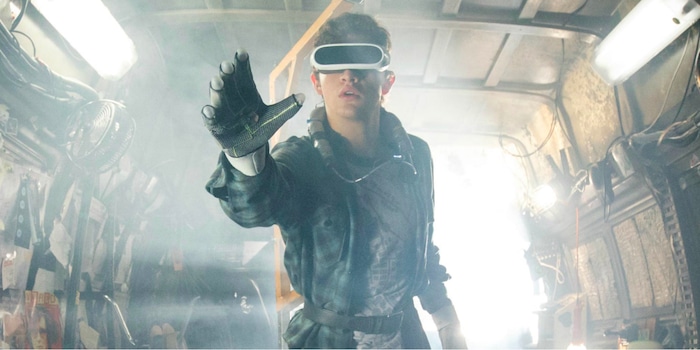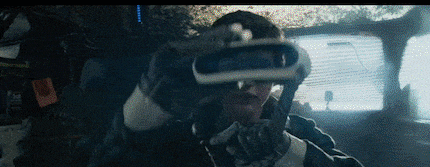
How far away are we from the Oasis from "Ready Player One"?
Are we facing a VR-dominated future like in "Ready Player One" and the Oasis? If so, when? In 10, 20 or 50 years? The dystopian future may be closer than we think.
In the current cinema film "Ready Player One", the world's population spends most of its time in a virtual universe called Oasis. Equipped with headsets, gloves and treadmills, people can move around freely and do practically anything they want. Game, go to school, work, use love services, visit faraway countries, the list is endless. How far away are we from this fantasy?
Despite the sales success of PS VR, HTC Vive and the like, the majority of people have not yet fallen for the VR hype. Nevertheless, most of the prerequisites for the Oasis are already in place. I'll tell you what you need to create the next best Oasis experience and ask an expert how much longer we have to wait for the full version.
VR glasses

The most important tool for experiencing the virtual world is the headset. In the film, or rather the book, a wide variety of headsets are used. For full immersion, it is crucial that the resolution of the headset is high enough that individual pixels can no longer be perceived. A 4K headset would achieve this. We'll leave aside the fact that it has to project the image onto the eyes using a laser in order to cover 100 per cent of the field of vision. At 2880×1600 pixels, the HTC Vive Pro has the highest resolution of the popular headsets to date. It's not quite Oasis-ready yet. Today's devices are also much clunkier and only wireless with adapters. However, the basic requirements are met.
Suit
Those who can afford it in the world of "Ready Player One" own the Shaptic Bootsuit. Described in the book as an exoskeleton that recognises the wearer's movements and transmits them into the game. Conversely, the wearer senses every touch that happens to them in the game. So if you are hit by a projectile, fire a weapon or receive a shock, you will also feel it in real life.
The Synesthesia Suit, which was developed for "Rez Infinity", covers at least the second part. Using 26 integrated vibrators, you can feel the sound of the game's various instruments.
The Teslasuit, which features haptic feedback, movement tracking and even biometric feedback, is set to be more complete. The suit is set to go on sale next year.
Walking belt/seat
Treadmills transfer your leg movements into the game: running, jumping, running. They resemble a classic training treadmill, allowing you to move in place. One device that currently comes closest to this image is the KAT Walk mini. You stand on a round, inwardly curved surface. A hip belt attached to it ensures that you don't fall over and stay in the same place. The cable problem is also solved with the KAT Walk mini. You won't be able to move quite as freely as in the model, but it's close.
Also interesting is the Infinadeck, which looks almost identical to the treadmill used by the main character Wade in the film. However, it's not quite as hectic yet.
The book describes a seat (Shaptic Technologies HC5000) that is attached to two robotic arms and can therefore even enable head movements or simulate falling. This fictitious armchair is also capable of haptic feedback.
The Axon VR Exosuit, which was presented in 2016, goes in the same direction. Here, too, you are held by two robotic arms so that you can move your legs freely. However, somersaults are not yet possible. Haptic feedback and even heat on the arms, body etc. are simulated by a fabric-like cover that covers the body. However, like many other similar projects, the Axon Suit is still in its infancy. The company is now called HaptX and has set itself a somewhat more moderate intermediate goal in the meantime, as the next section shows.
Gloves
Let's take a step back. After all, not everyone in "Ready Player One" has expensive high-end equipment lying around. In addition to the goggles, the standard equipment includes data gloves. Today's VR solutions still rely on traditional controllers. However, there are already some promising alternatives in development with varying degrees of market maturity.
The HaptX Gloves, which can simulate the feeling of gripping, pressing and touching, are somewhat reminiscent of a Terminator killer hand. This is made possible by over 100 pressure points and up to 2.5 kg of resistance per finger. Of course, individual finger movements are also recognised and transferred to the game.
Software
The best hardware is nothing without its software counterpart. There is currently no VR app that combines games, entertainment and virtual living space like the Oasis. It would have to be a global MMO with different worlds that leave nothing to the imagination. A VR version from Facebook would probably come closest to this. Nowhere else are there so many shared users and so many different possibilities for entertainment. "Second Life" would also be a step in the right direction.
If we restrict ourselves to the game part, then games like "Star Citizen" or "Worlds Adrift" come to mind. They want as many players as possible to inhabit a universe at the same time and let them work freely there. However, they are nowhere near the millions of simultaneous users in "Ready Player One" or the complex interaction possibilities. The graphics are also not yet so good that we can't tell the difference between games and reality.
"VRChat" and "Altspace" should not go unmentioned. Both have created their own small VR worlds in which people can interact with each other. "Altspace" even offered real jobs.
And how much longer do we have to wait for the fun?
So the technology and software are already in place to varying degrees. But how long will it be before it matches the level of the book? To clarify this question, I contacted Fabian Freund, co-founder and CTO of the Zurich-based company True VR Systems. The company is responsible for the technology in the Fusion Arena in Letzipark and in its own VR centre in Dietlikon. Although he has neither seen the film nor read the book, he has heard enough to get an idea of the fictional future.
"The biggest problem is compatibility," says Fabian. As long as manufacturers do not work closely together, the idea of Oasis is unrealistic. There is still no standardised platform. Everyone is doing their own thing. Fabian is convinced that exclusivity will continue to be a topic in the coming years. "What's more, everything is still extremely expensive and complicated to implement," says Fabian, citing Striker VR as an example. The Striker VR is a sci-fi rifle that was developed for VR arenas and is a long way from plug 'n' play. However, the technology is advancing in leaps and bounds. "In 30 years (the story takes place in 2044), we will be much further along than in "Ready Player One". Some of the technology in the trailer even looks antiquated by today's standards". Fabian predicts that it won't be that long until the haptics and resolution are at the level of the sci-fi novel. "We developed our VR system in just two years and there was nothing comparable before that."
The sticking point will be the actual Oasis
Fabian is more critical of the software. Who is supposed to develop such a huge construct? Who can handle the immense computing and data performance? Unlike in "Ready Player One", we will hardly need a local console to immerse ourselves in the virtual world in the future. This will be done by a data centre somewhere in the world. Google and Facebook come to Fabian's mind as the two companies most likely to create such a parallel universe. Both are eagerly researching this and also have their own VR hardware on sale.
As mentioned, VRChat and Altspace are examples of such parallel worlds. A place primarily for nerds. In order to penetrate the mass market, the gamer stigma must first be shaken off, says Fabian. "The social aspect is still far too weak. As long as we can't interact with our friends like in real life, it will never replace reality." However, when future generations grow up with a VR world, social interactions in this way may be so normal for them that they won't miss "real" encounters at all. He believes that it is extremely plausible that jobs are migrating from the IT sector to VR. The future remains exciting. So let's still enjoy the time when we can snap at each other face to face and enjoy each other's vapours on public transport. Nobody in VR will probably miss the latter.
As a child, I wasn't allowed to have any consoles. It was only with the arrival of the family's 486 PC that the magical world of gaming opened up to me. Today, I'm overcompensating accordingly. Only a lack of time and money prevents me from trying out every game there is and decorating my shelf with rare retro consoles.
Interesting facts about products, behind-the-scenes looks at manufacturers and deep-dives on interesting people.
Show all